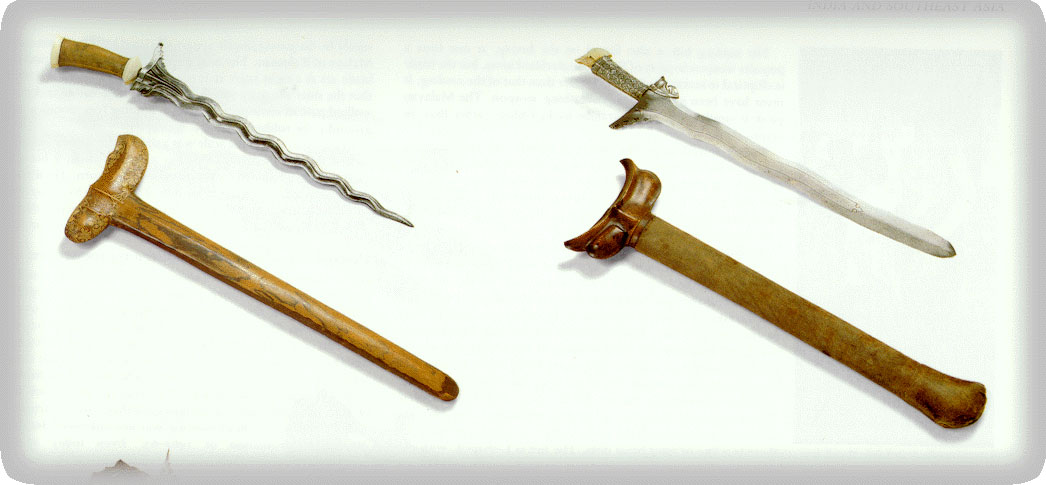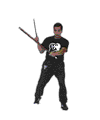Kris Weapons
Before the invention of the gun, the knife was generally regarded as the most used weapon. In its many shapes and sizes, it is found in all nations throughout the ages. In South East Asia, the most widely used and popular knife is the KRIS. It is a very old weapon which survives even to this day. The kris is believed to have originated in Java, Indonesia in the 14th century by a Janggalo king named Inakto Pali. From Java it was then exported to other places in Asia (i.e., Malaysia, Singapore, Burma, Borneo and the Philippines).
Most importantly, the kris serves three purposes:
- an object of cult,
- a fighting weapon; and
- an execution devise.

Kris Blade

Every island has its unique shape or form of the blade, hilt and scabbard. Adding to the confusion, different origins may be found on the same kris. To cite and example, a kris may have a Bali made blade, a Javan hilt and a Sumatran scabbard. However the kris blade is very unique in its general design. A typical kris blade widens out into a sharp point next to the handle on one, or in some cases, on both sides. This point serves the function of a guard and is often notched to catch the opponent’s weapon. The kris blade (wilah) is found in three types of form. Some blades are wavy (dapor loq) while others are straight (dapor bener).
Blades may be found with a combination of straight and wavy patterns. Some blades have waves next to the hilt or the point while some have waves on the entire length of the blade and may have from five to fifteen waves (kris cherita). Contrary to popular belief, straight blades outnumber the wavy variety.
Sizes and weights also vary from six inches long weighing a couple of ounces to two feet long weighing close to two pounds. In the Philippines, krises are much larger and heavier than those found in Indonesia. On the other hand, Philippine krises lack the “watered pattern”characteristic of Java or Bali blades.
The blades of the kris are two types. The first type is made from strips of iron or steel forged together in varying quality. The more valuable and beautiful kind are blades made from alternate layers of steel and meteoric iron which contain about three percent nickel. They are then twisted, welded in certain ways and then etched with a mixture of lime juice and arsenic to create different patterns on the blade (the watered steel pattern).
Manifested for Good Purposes
In Malaya and Southern Philippines, the kris was part of the dress code much like the samurai swords of old Japan. Every man owned at least one and in times of war may carry as many as three of these weapons. These weapons may be a family heirloom, a gift, if married, from his father-in-law and a personal weapon. The last kris is usually carried at the left side ready for immediate use while the other two are carried at the right side and back. During times of peace, the kris is usually carried at the right side only — for to carry it in any other fashion is considered rude and insulting.
As an object of cult, the kris is much revered as the swords of the samurai. There are many myths associated with the kris. Some of the natives of Indonesia and Malaysia, for example, have confessed that they have seen water drawn from the weapon. It is also believed that the kris could perform amazing feats. The very act of death could be performed by merely pointing the weapon at the intended victim. This power is known in Malay as sorcery by pointing (tuju) and is well feared. The kris is also believed to have the power to jump out of its scabbard on its own accord and engage in a battle with an enemy. It is also believe to be able to rattle on its own scabbard to call notice and warn its owner of an impending danger or threat.
The association of supernatural power with the kris is perhaps linked to the mysticism of the orient in addition to the natural instinct of self-preservation. Hence superior fighting skills have been invariably associated and credited to the supernatural attributes of the weapon. One of the intriguing aspects of the kris is its close association with religion. This association can be explained by their common goal of protecting the believer and owner of the weapon from danger. It is a firm belief that the powers of religion and of the kris could only be manifested for good purposes. Inspite of the variety of weapons found on the archipelago, none is closely related to the social and religious ideas than the kris. The average person would feel incomplete without his ubiquitous kris. The kris is a mark of social distinction and is regarded as an “inseparable brother of men”. It is regarded as man’s tutelary spirit and a means of communicating with one’s ancestors.
Premier Fighting & Defending Weapon
In battle, the kris is used mainly as a thrusting weapon. With a single kris, one holds the scabbard in the left hand with the straight part extending along the forearm guarding and shielding it. The blade, held in the right hand, is used to stab the ‘soft’ targets such as the abdomen, the kidney and the throat. With two krises, the favored kris is taken in the right hand as premier fighting weapon and the other is used as a defending or guarding weapon. In this position, the kris is held against the forearm with the edge and point at the top outward. In this position, the kris is used defensively and a slight movement against an opponent’s attack will result in a cut.
Interestingly the kris is also used as the ceremonial and official weapon in the execution of criminals. One method of execution using the kris is to have the condemned man sitting in a chair with his arms extended and held horizontally by two men. The executioner, positioned behind the victim, stabs him perpendicularly above and inside the collar bone, puncturing his lungs and penetrating straight into the heart, causing instant death.

There are few places remaining in the world today where a weapon is an important part of the religion, tradition and culture of the people. In South East Asia, the kris is still regarded and honored as an integral part of person’s being. It is believed that his weapon, the kris, along with its power and spirit, endows him with the spiritual and physical virtues to meet the challenges of life.
Ramon Villardo is a Toronto, Canada based martial artist. He is a member of Bakbakan International’s Toronto Chapter and is a collector of Philippine and Indonesian fighting weapons. Ramon is also a former member of the Japanese Sword Society of Canada (JSSC).
Bibliography:
- Draeger, Donn: “The Weapons and Fighting Arts of Indonesia”
- Draeger, Donn and Smith, Robert: “Comprehensive Asian Fighting Arts”
- Solc, Vaclav: “Swords and Daggers of Indonesia”
- Stone, George Cameron: “Glossary of the Constructions and Use of the Arms and Armours”

